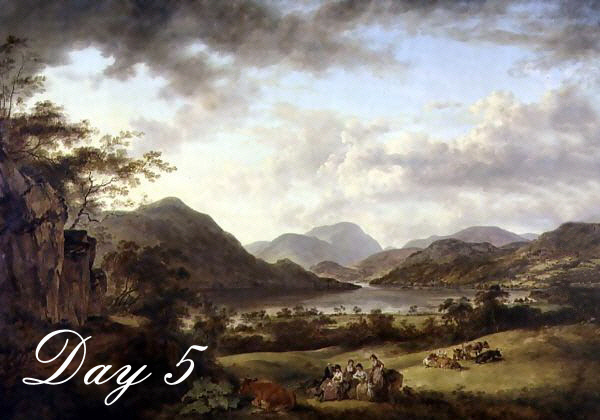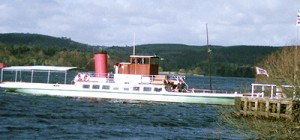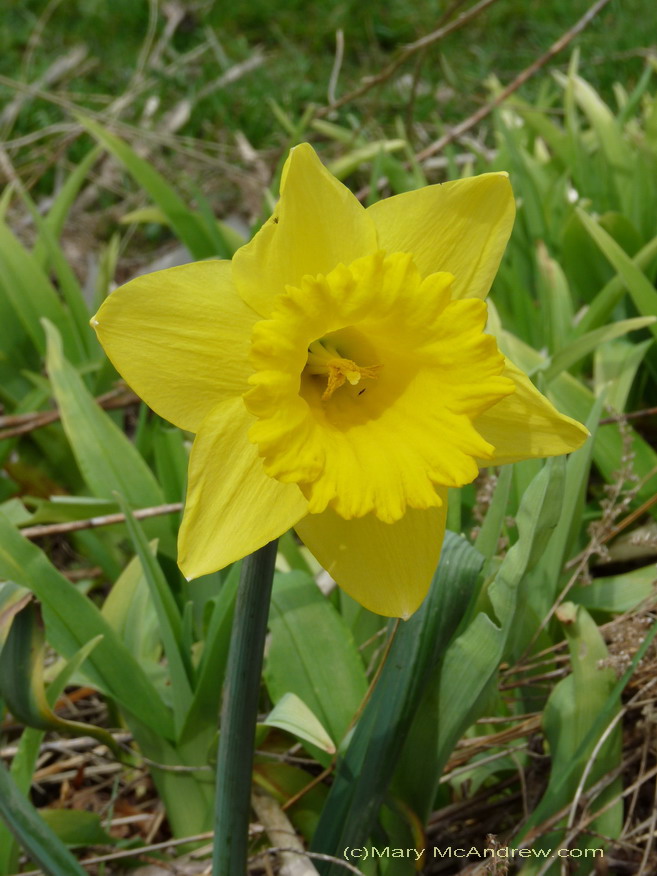return to: Home > Creative Vision Tours > Great Lakelanders > < Day 4 ….. Day 6 >
Today we cross the central mountains of Lakeland through the Kirkstone pass to visit the area around Lake Ullswater. 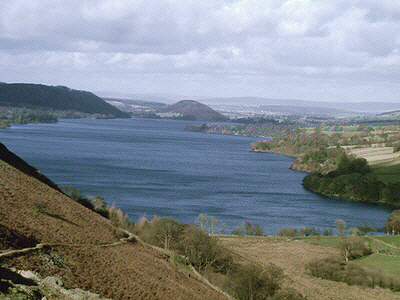 Many regard Ullswater as the most beautiful of the English lakes and draw comparisons with Lake Lucerne in Switzerland. It is the second largest lake in the English Lake District, being approximately 9 miles (14.5 kilometres) long and 0.75 miles (1,200 metres) wide with a maximum depth of slightly more than 60 metres (197 ft). Ullswater is a typical “ribbon lake” and was formed after the last ice age, when a glacier scooped out the valley floor, the deepened section filled with melt water when the glacier retreated, forming the lake which takes the form of an elongated ‘Z’. The lake is fed by a number of streams called which locals call Becks, which cascade down the sides of the adjoining high mountains. One of these streams Aira Beck, has a spectacular 70′ waterfall Aira Force which is the subject of our first walk of the day.
Many regard Ullswater as the most beautiful of the English lakes and draw comparisons with Lake Lucerne in Switzerland. It is the second largest lake in the English Lake District, being approximately 9 miles (14.5 kilometres) long and 0.75 miles (1,200 metres) wide with a maximum depth of slightly more than 60 metres (197 ft). Ullswater is a typical “ribbon lake” and was formed after the last ice age, when a glacier scooped out the valley floor, the deepened section filled with melt water when the glacier retreated, forming the lake which takes the form of an elongated ‘Z’. The lake is fed by a number of streams called which locals call Becks, which cascade down the sides of the adjoining high mountains. One of these streams Aira Beck, has a spectacular 70′ waterfall Aira Force which is the subject of our first walk of the day.
The term “force” is a Lakeland term for “waterfall”; which has its origins in the Old Norse word fors. 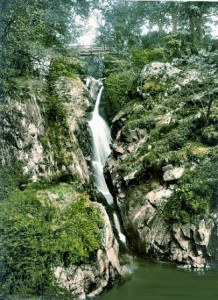 Aira Force is a spectacular, roaring waterfall which falls over seventy feet of rock and produces a light mist which sweeps gently through the surrounding woodland. There are bridges above and below the force which afford superb views, the upper is an old pack horse bridge. In the 1780′s the Howard family of Greystoke Castle (which has literary associations with the book Tarzan) had an old hunting lodge or Pele tower close to the shore of Ullswater and renovated it into what is now Lyulph’s Tower, set among its own sporting estate. They landscaped the area around the Aira force, and used it as an informal garden, planting over half a million native and ornamental trees, and established a network of tracks, footpaths and bridges. In 1846 the Howard’s created an arboretum below Aira Force, planting over 200 specimen conifers (firs, pines, spruces and cedars) from all over the world, including a Sitka Spruce, now 118 feet high. This estate is now open to the public and we will undertake a short circular walk to follow Aira Beck onto the hill to be rewarded with breathtaking views across the lake before returning on another route to the shores of Lake Ullswater.
Aira Force is a spectacular, roaring waterfall which falls over seventy feet of rock and produces a light mist which sweeps gently through the surrounding woodland. There are bridges above and below the force which afford superb views, the upper is an old pack horse bridge. In the 1780′s the Howard family of Greystoke Castle (which has literary associations with the book Tarzan) had an old hunting lodge or Pele tower close to the shore of Ullswater and renovated it into what is now Lyulph’s Tower, set among its own sporting estate. They landscaped the area around the Aira force, and used it as an informal garden, planting over half a million native and ornamental trees, and established a network of tracks, footpaths and bridges. In 1846 the Howard’s created an arboretum below Aira Force, planting over 200 specimen conifers (firs, pines, spruces and cedars) from all over the world, including a Sitka Spruce, now 118 feet high. This estate is now open to the public and we will undertake a short circular walk to follow Aira Beck onto the hill to be rewarded with breathtaking views across the lake before returning on another route to the shores of Lake Ullswater.
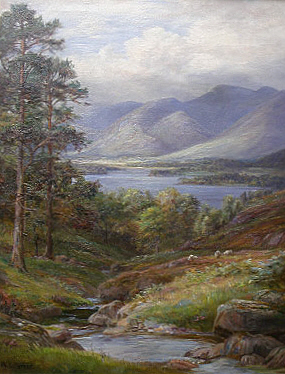 Prior to boarding our coach we will visit nearby Glencoyne Bay where Wordsworth observed a group of wild daffodils in flower and was moved to write his poem “Daffodils” which has become almost synonymous with his name and recently voted Britain’s most favourite verse. (Please see a copy of it at the bottom of this page.)
Prior to boarding our coach we will visit nearby Glencoyne Bay where Wordsworth observed a group of wild daffodils in flower and was moved to write his poem “Daffodils” which has become almost synonymous with his name and recently voted Britain’s most favourite verse. (Please see a copy of it at the bottom of this page.)
In the afternoon we will travel to Pooley Bridge on the southern edge of the lake for a pub lunch and a look at the old stone bridge by which it is named. At “Eusemere”, close to the village, lived Thomas Clarkson (1760–1846) who was a strong campaigner for the abolition of slavery and whose house was frequently visited by William and Dorothy Wordsworth, with whom he was very good friends. It was after visiting Clarkson in April 1802, that Wordsworth was inspired to write the poem “Daffodils” after seeing daffodils growing on the shores of Ullswater on his journey back to Grasmere by horse carriage. Wordsworth once wrote of Ullswater: “it is the happiest combination of beauty and grandeur, which any of the lakes affords” we are sure after visiting the lake you will also be similarly inspired.
From Pooley Bridge we travel 2 miles eastwards to Dalmain House and Gardens. What appears to be a fine example of a 17th century English Country House is in fact a a facade added in 1744 and the house has a much earlier history dating back to Medieval period or perhaps earlier. However the majority of the present structure is the consequence of alterations carried out in the 16th century and inside we will see a Tudor Fretwork Room containing a magnificent sixteenth century plaster ceiling and oak paneling, while the Chinese Room boasts original hand painted wallpaper. The House also has a superb 5 acre plantsman’s garden having an unusual combination of flowers and a famous display of Himalayan blue poppies in the early summer. Dalmain hosts a number of events throughout the year and our tour schedule may occasionally coincide with visiting the house during one of these events, which include; The North-West Horse Carriage Driving event, The Cumbria Life & Dalemain Garden Festival and The Dalemain Food & Craft Fair.
dating back to Medieval period or perhaps earlier. However the majority of the present structure is the consequence of alterations carried out in the 16th century and inside we will see a Tudor Fretwork Room containing a magnificent sixteenth century plaster ceiling and oak paneling, while the Chinese Room boasts original hand painted wallpaper. The House also has a superb 5 acre plantsman’s garden having an unusual combination of flowers and a famous display of Himalayan blue poppies in the early summer. Dalmain hosts a number of events throughout the year and our tour schedule may occasionally coincide with visiting the house during one of these events, which include; The North-West Horse Carriage Driving event, The Cumbria Life & Dalemain Garden Festival and The Dalemain Food & Craft Fair.
I wandered lonely as a cloud That floats on high o’er vales and hills, When all at once I saw a crowd, A host, of golden daffodils; Beside the lake, beneath the trees, Fluttering and dancing in the breeze. Continuous as the stars that shine And twinkle on the milky way, They stretched in never-ending line Along the margin of a bay: Ten thousand saw I at a glance, Tossing their heads in sprightly dance. The waves beside them danced; but they Out-did the sparkling waves in glee: A poet could not but be gay, In such a jocund company: I gazed – and gazed – but little thought What wealth the show to me had brought: For oft, when on my couch I lie In vacant or in pensive mood, They flash upon that inward eye Which is the bliss of solitude; And then my heart with pleasure fills, And dances with the daffodils. William Wordsworth (1770-1850)Highlights:
- Kirkstone pass
- Lake Ullswater – second largest in the Lake district
- Aira Force waterfall
- Aira Beck – walk along the stream
- Arboretum at Aira Force
- Glencoyne Bay - inspiration site of the poem “The Daffodils”
- Pooley Bridge
- Martin Dale – views, church from 1220 and a yew tree over 1000 yrs old
- Ullswater Steam boat
- Glenridding




